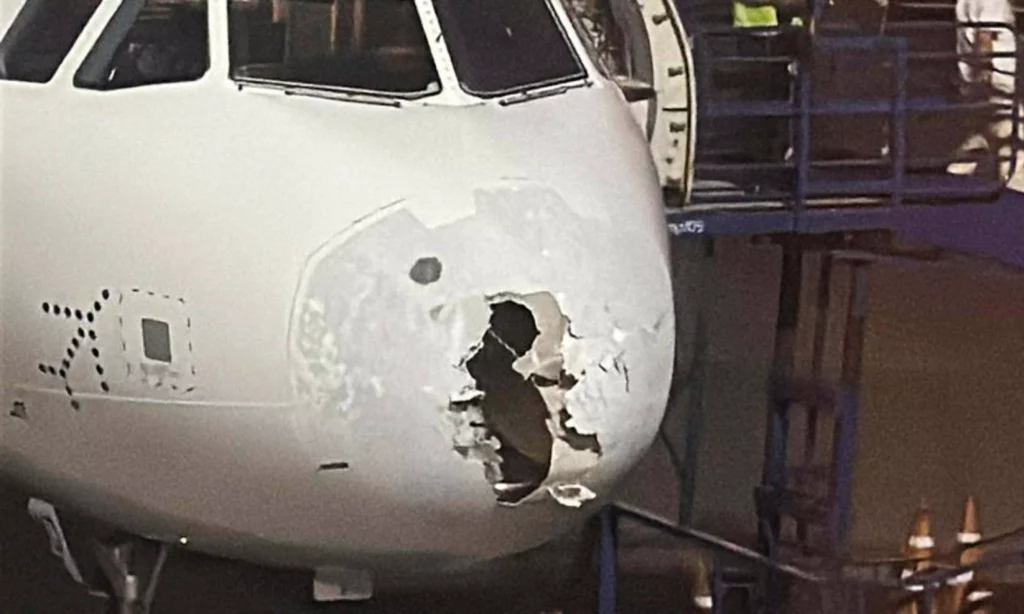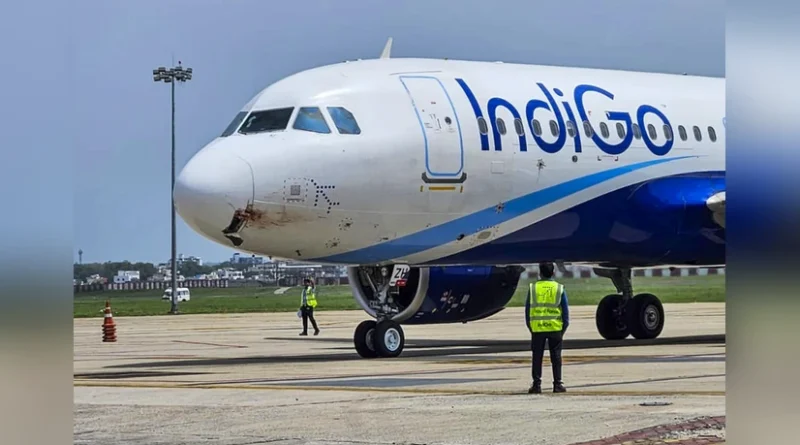IndiGo Flight 6E-2142 Nose Damage Incident: DGCA Probe Cites Severe Weather and Delayed Rerouting
On May 21, passengers aboard IndiGo flight 6E-2142 from Delhi to Srinagar experienced a harrowing journey after the Airbus A321 aircraft encountered a severe hailstorm mid-flight. The incident, which damaged the plane’s nose cone, has now been investigated by the Directorate General of Civil Aviation (DGCA), with the findings pointing to severe weather conditions and non-timely action in rerouting as the probable causes.

The flight carried over 220 people, including a five-member delegation from the Trinamool Congress (TMC). Despite the turbulence and structural damage to the aircraft, the pilots landed safely at Srinagar airport without any injuries to passengers or crew.
How the Incident Unfolded
The aircraft, registered as VT-IMD, departed from Delhi at 5:13 p.m. According to flight tracking data, the journey seemed routine until the plane approached the Pathankot area around 45 minutes into the flight.
At FL360 (36,000 feet), the crew switched on the seat belt signs as turbulence began to intensify. The aircraft soon entered a severe hailstorm, which battered the fuselage and damaged the radome — a weatherproof, aerodynamic cover at the aircraft’s nose that protects the radar antenna. The radome is built with materials that allow radar waves to pass through with minimal interference, and any damage to it can compromise the aircraft’s weather-detection capabilities.
Crew’s Efforts to Avoid the Storm
In their statement to the DGCA, the pilots explained that they had attempted multiple measures to avoid the dangerous weather system. First, they requested the Indian Air Force (IAF) Northern Area Control for permission to deviate left toward the India-Pakistan international border. This would have taken them around the storm, but the request was denied due to existing airspace restrictions.
The crew then contacted Lahore Air Traffic Control (ATC) to request temporary entry into Pakistani airspace — a “no-go” zone for Indian commercial aircraft since the 2019 closure of Pakistani skies to Indian flights following the Pahalgam terror attack. This request, too, was refused.
With limited options and proximity to the thunderstorm, the pilots first considered returning to Delhi but determined that they were too close to the storm cell. Ultimately, they decided to continue on their present heading, penetrating the weather system to exit it in the shortest possible time toward Srinagar.
The Hailstorm Encounter
Once inside the storm, the aircraft faced severe turbulence and was pelted by hail. Speed variations were significant, altitude changes were rapid, and the pilots switched to manual flying to maintain control. Several system warnings appeared in the cockpit, including alerts for “angle of attack fault,” “alternate law protection lost,” and “backup speed scale unreliable.”
Despite these challenges, the flight crew navigated the storm and continued toward Srinagar, landing safely at 6:30 p.m. Passengers described the episode as “terrifying,” though they expressed relief at the crew’s ability to land without injuries.
DGCA Investigation Findings
Minister of State for Civil Aviation Murlidhar Mohol presented the investigation findings in the Rajya Sabha, stating that the DGCA identified two probable causes:
- Severe weather en-route — The flight’s path intersected with an intense hailstorm and associated turbulence.
- Non-timely action in rerouting — The aircraft was not rerouted away from the hazardous weather early enough to avoid the encounter.
While the report did not assign blame to a specific party, it highlighted the critical role that proactive rerouting decisions play in flight safety.
Indian Air Force’s Role in Route Assistance
The IAF Northern Area Control, which manages airspace over sensitive border regions, has defended its handling of the situation. Sources indicated that the crew was immediately assisted in contacting Delhi Area Control and provided frequencies for Lahore ATC in case of overflight clearance for weather diversion.
Once Lahore refused clearance, the IAF continued to guide the aircraft, offering control vectors and groundspeed readouts until it landed at Srinagar airport, where air traffic services are also managed by the IAF.
Airspace Restrictions and Their Impact
Since 2019, Pakistani airspace has been closed to Indian commercial aircraft, forcing airlines to use longer routes or alternative paths even in emergency situations. This restriction became a significant factor in the IndiGo flight’s inability to avoid the storm, as the quickest detour would have involved briefly entering Pakistani territory.
The incident raises questions about how such geopolitical restrictions intersect with aviation safety during weather-related emergencies.
Aircraft Status and Maintenance
Following the incident, the Airbus A321 was grounded at Srinagar for detailed inspections and repairs. The radome damage was substantial, requiring replacement before the aircraft could return to service. Technicians also examined the fuselage and key systems for any additional hail-related damage.
Passenger Experience
Passengers reported feeling a sudden drop in cabin temperature and hearing loud banging noises as hail hit the aircraft. Some said they felt the plane shake violently, while others noticed flashing lights outside as the storm raged.
While no injuries occurred, the psychological impact of such an event is significant. Many passengers praised the crew for their professionalism under extreme pressure.
Lessons for Aviation Safety
The incident underscores the importance of:
- Early weather avoidance — Advanced weather radar and timely decision-making are essential to prevent flights from encountering severe storms.
- Cross-border coordination — In emergencies, safety considerations may require flexible airspace access agreements, even between countries with tense relations.
- Pilot training for extreme conditions — Manual flying skills and storm navigation remain critical competencies for airline pilots.
Final Thoughts on the IndiGo Nose Damage Incident
The IndiGo flight 6E-2142 episode is a stark reminder of how quickly a routine journey can turn into a high-stress emergency in aviation. While the DGCA probe points to severe weather and delayed rerouting as probable causes, the crew’s skill in landing the plane safely prevented what could have been a far more serious outcome.
This case also brings into focus broader issues such as geopolitical airspace restrictions, the necessity for rapid weather avoidance decisions, and the resilience of both crew and passengers in facing unexpected challenges.
Moving forward, enhanced coordination between civil and military aviation authorities, coupled with investments in weather detection and route planning, can help ensure that similar incidents are avoided — or, at the very least, managed with minimal risk.
Follow us for more news at Valleynewz.com

